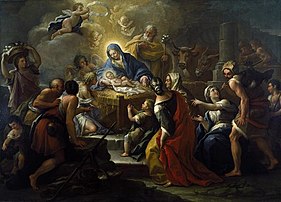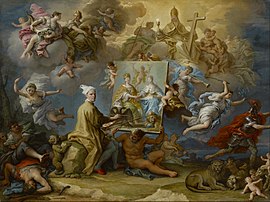You can help expand this article with text translated from the corresponding article in Italian. (December 2022) Click for important translation instructions.
|
| Paolo de' Matteis | |
|---|---|
 Self-portrait Self-portrait | |
| Born | (1662-02-09)9 February 1662 Piano Vetrale |
| Died | 26 January 1728(1728-01-26) (aged 65) Kingdom of Naples |
| Nationality | Italian |
| Known for | Painting |
| Movement | Baroque |
Paolo de Matteis (also known as Paolo de' Matteis; 9 February 1662 – 26 January 1728) was an Italian painter.
Biography
He was born in Piano Vetrale, a hamlet of Orria, in the current Province of Salerno, and died in Naples. He trained with Francesco di Maria in Naples, then with Luca Giordano. He served in the employ of the Spanish Viceroy of Naples. From 1702 to 1705, de' Matteis worked in Paris, Calabria, and Genoa. In Genoa, he painted an Immaculate Conception with St. Jerome Appearing to St. Sevrio.
Returning to Naples, he painted decorative schemes for Neapolitan churches, including the vault of the chapel of San Ignatius in the church of Gesù Nuovo in Naples. He also painted an Assumption of the Virgin for the Abbey at Monte Cassino. Between 1723 and 1725, de' Matteis lived in Rome, where he received a commission from Pope Innocent XIII.
He had as pupils Filippo Falciatore, Francesco Peresi, and members of the Sarnelli family including Francesco, Gennaro, Giovanni, and Antonio Sarnelli. Others who were his pupils were Giuseppe Mastroleo, Giovanni Pandozzi, Michelangelo Buonocore, Domenico Guarino, Antonio Fumo and Nicola de Filippis.
Gallery
-
 The Adoration of the Shepherds,
The Adoration of the Shepherds,
Dallas Museum of Art -
 The Annunciation (1712)
The Annunciation (1712)
-
 Adoration of the Shepherds (1710–15)
Adoration of the Shepherds (1710–15)
-
 Cain and Abel (1690)
Cain and Abel (1690)
-
 Allegory of the Consequences of the Peace of Utrecht
Allegory of the Consequences of the Peace of Utrecht
-
The Triumph of the Immaculate
See also
- Santa Maria di Montesanto, Naples, for one of his works
- In 1996, the United States Postal Service issued a Christmas stamp based on his Adoration of the Shepherds.
References
- Artnet biography from Grove encyclopedia of Art.
- Getty Museum biography.
- Hobbes, James R. (1849). Picture collector's manual; Dictionary of Painters. London: T. & W. Boone. pp. 153.
- Storia della pittura in Napoli ed in Sicilia dalla fine del 1600 al principio del 1800, Volume 1, by Carlo Tito Dalbono, 1859, Naples, page 154.
- J.R. Hobbes p. 154
- "1996 32c Traditional Christmas: Madonna and Child".
External links
![]() Media related to Paolo de Matteis at Wikimedia Commons
Media related to Paolo de Matteis at Wikimedia Commons